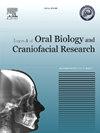牙髓干细胞作为口腔黏膜下纤维化的新型抗纤维化疗法:体外研究
Q1 Medicine
Journal of oral biology and craniofacial research
Pub Date : 2025-02-15
DOI:10.1016/j.jobcr.2025.02.002
引用次数: 0
摘要
背景:口腔粘膜下纤维化(OSMF)是一种慢性、潜在的恶性疾病,与槟榔的食用有关。它的特点是进行性纤维化、牙关紧闭和恶性肿瘤的显著风险,治疗选择有限,主要提供症状缓解。牙髓干细胞(DPSCs)是一种间充质干细胞(MSCs),已显示出通过其免疫调节和再生特性调节纤维化状况的潜力。本研究在体外模型中评估了DPSCs对OSMF成纤维细胞的抗纤维化潜力。方法从健康恒牙中分离sdpscs,采用流式细胞术检测MSC标志物(CD73、CD90、CD44、CD105)。从OSMF活检样本中培养成纤维细胞,并通过磁分选和形态学分析进行验证。通过胶原凝胶收缩、增殖、TGF-β1分泌、形态学变化等检测评价DPSCs对成纤维细胞的抗纤维化作用。使用适当的检验对数据进行统计学显著性分析。结果dpsc治疗组胶原凝胶平均粒径由对照组的3.235 mm (95% CI: 1.65 ~ 4.82 mm)降至1.00 mm (95% CI:−0.27 ~ 2.27 mm)。成纤维细胞活力在72 h内显著下降(p <;0.05)。TGF-β1分泌在dpsc处理的成纤维细胞中明显降低(339.38 pg/mL vs 637.61 pg/mL, p = 0.000393, Cohen’s d = 19.15)。结论dpscs通过抑制胶原收缩、抑制成纤维细胞增殖、减少TGF-β1分泌,具有较强的抗纤维化作用。这些发现表明,DPSCs是一种很有前景的OSMF细胞治疗方法。临床转化需要进一步的体内研究。试验注册号不适用。本文章由计算机程序翻译,如有差异,请以英文原文为准。

Dental pulp stem cells as a novel antifibrotic therapy for oral submucous fibrosis: An in vitro study
Background
Oral submucous fibrosis (OSMF) is a chronic, potentially malignant disorder associated with areca nut consumption. It is characterized by progressive fibrosis, trismus, and a significant risk of malignancy, with limited treatment options primarily offering symptomatic relief. Dental pulp stem cells (DPSCs), a type of mesenchymal stem cells (MSCs), have shown potential for modulating fibrotic conditions through their immunomodulatory and regenerative properties. This study evaluates the antifibrotic potential of DPSCs on OSMF fibroblasts in an in vitro model.
Methods
DPSCs were isolated from healthy permanent teeth and characterized using flow cytometry for MSC markers (CD73, CD90, CD44, CD105). Fibroblasts were cultured from OSMF biopsy samples and validated through magnetic sorting and morphological analysis. The antifibrotic effects of DPSCs on fibroblasts were evaluated using assays for collagen gel contraction, proliferation, TGF-β1 secretion, and morphological changes. Data were analyzed for statistical significance using appropriate tests.
Results
The mean collagen gel size decreased from 3.235 mm (95 % CI: 1.65–4.82 mm) in the control group to 1.00 mm (95 % CI: −0.27 – 2.27 mm) in the DPSC-treated group. Fibroblast viability declined significantly over 72 h (p < 0.05). TGF-β1 secretion was markedly lower in DPSC-treated fibroblasts (339.38 pg/mL vs 637.61 pg/mL, p = 0.000393, Cohen's d = 19.15).
Conclusion
DPSCs exhibit strong antifibrotic properties by inhibiting collagen contraction, suppressing fibroblast proliferation, and reducing TGF-β1 secretion. These findings suggest DPSCs as a promising cell-based therapy for OSMF. Further in vivo studies are warranted for clinical translation.
Trial registration number
Not applicable.
求助全文
通过发布文献求助,成功后即可免费获取论文全文。
去求助
来源期刊

Journal of oral biology and craniofacial research
Medicine-Otorhinolaryngology
CiteScore
4.90
自引率
0.00%
发文量
133
审稿时长
167 days
期刊介绍:
Journal of Oral Biology and Craniofacial Research (JOBCR)is the official journal of the Craniofacial Research Foundation (CRF). The journal aims to provide a common platform for both clinical and translational research and to promote interdisciplinary sciences in craniofacial region. JOBCR publishes content that includes diseases, injuries and defects in the head, neck, face, jaws and the hard and soft tissues of the mouth and jaws and face region; diagnosis and medical management of diseases specific to the orofacial tissues and of oral manifestations of systemic diseases; studies on identifying populations at risk of oral disease or in need of specific care, and comparing regional, environmental, social, and access similarities and differences in dental care between populations; diseases of the mouth and related structures like salivary glands, temporomandibular joints, facial muscles and perioral skin; biomedical engineering, tissue engineering and stem cells. The journal publishes reviews, commentaries, peer-reviewed original research articles, short communication, and case reports.
 求助内容:
求助内容: 应助结果提醒方式:
应助结果提醒方式:


